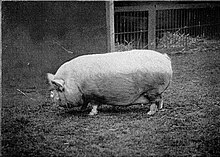Yorkshire pigs
Yorkshire pigs form a widely branched group of white domestic pigs , all of which are descended from the Yorkshire pig of the northern English county of the same name. Yorkshire pigs are one of the most popular and influential pig breeds in the world. They are available in numerous variants and types. Their genes are also found in many European land races, such as the German landrace .
Ancestors were Northern English white land races with long heads, long backs and lop ears.
Large white
The "Large White", "Edelschwein" or "Yorkshire" is a large, white pig with erect ears. The breed is considered to be the most common breed of pig in the world. It has been kept in Japan and many European countries since the end of the 19th century and paired with native breeds there. In Germany it formed the basis for the Edelschwein .
The Large White emerged in the middle of the 19th century from down-to-earth English varieties (Leicester, Coleshill, Suffolk, Middlesex), into which precocious breeds from Portugal and Naples as well as Chinese breeds were crossed. The most typical pigs were kept in the county of Yorkshire , which is why they were also called "Yorkshire" abroad.
Small white
The "Small White" or "Little Yorkshire" was a British breed of pig that was common in the 19th century. It was derived from crossing the traditional old Yorkshire pig with imported Chinese pigs. As a “lover's pig”, it was a popular status symbol for aristocrats and hobbyists who could afford to keep it, and was not originally used as a fattening pig.
The Little Yorkshire was crossed with other breeds such as the Cumberland (†) and the Large White . From the cross with the Large White emerged the Middle White , whose popularity led to the extinction of the Small White in 1912.
Middle white
The "Middle White" or "Medium Yorkshire" comes from the cross of the " Large White " with the now extinct " Little Yorkshire ".
The robust, calm, medium-sized pig was also popular abroad and at times more popular than the "Large White" in the 1920s and 1930s. At the time it was also known as the "London Porker". After the Second World War, however, large pigs were in demand and their number, which was estimated at 470 pigs (= 0.01% of the British pig population) in 1955, fell. In 1976 there were only 3 boars and 34 breeding sows. The stocks have recovered a little. Nevertheless, the Middle White is one of the most endangered breeds in Great Britain, whose preservation is a goal of the Rare Breeds Survival Trust .
American Yorkshire
The "American Yorkshire" comes from the crossing of a Yorkshire boar exported to Lake Ontario around 1870 with Cheshire sows, also from England. The aim of breeding was a big stocky pig with big ham and shoulders. The US Yorkshire has small erect ears, a lot of lean meat and is mainly used as a "bacon pig" in the US. It is now common around the world.
proof
- ↑ a b c d e f Jens Mecklenburg: The other pig book . Of wild and domestic pigs, lucky charms and poor sows (= country life ). Cadmos Verlag, Schwarzenbek 2011, ISBN 978-3-8404-3003-9 , Yorkshire, pp. 96-97 .
- ↑ Hans Hinrich Sambraus: color atlas of farm animal breeds . 263 races in words and pictures. 7th expanded edition. Eugen Ulmer, Stuttgart 2011, ISBN 978-3-8001-7613-7 , Landrasse, p. 313 .
- ↑ a b c d Hans Hinrich Sambraus: Color atlas of farm animal breeds . 263 races in words and pictures. 7th expanded edition. Eugen Ulmer, Stuttgart 2011, ISBN 978-3-8001-7613-7 , Middle White, Mittelgroßes Yorkshire, pp. 319 .
- ↑ a b Hans Hinrich Sambraus: color atlas of farm animal breeds . 263 races in words and pictures. 7th expanded edition. Eugen Ulmer, Stuttgart 2011, ISBN 978-3-8001-7613-7 , Large White, p. 316 .
- ↑ a b The Middle White , British Pig Association, accessed January 14, 2016.
- ↑ Middle Whites , Eaves & Lewin, accessed February 23, 2010.
Additional information
-
Breeds of Livestock. Department of Animal Science - Oklahoma State University (English), therein:
- Yorkshire , 4th August 1999.
- Large White , May 24, 1996.
- Middle White , February 22, 2002.


